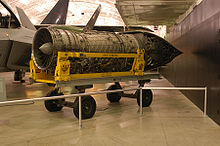Pratt & Whitney F119
The Pratt & Whitney F119 (manufacturer's designation PW5000 ) is a turbofan engine with afterburner that was specially developed for the Lockheed-Martin F-22 Raptor air superiority fighter by the US company Pratt & Whitney . It has 2D thrust vector control to increase maneuverability and also gives the F-22 supercruise capability.
The Pratt & Whitney F135 , which is used in the Lockheed Martin F-35 , is a further development of the F119 with over 190 kN of thrust.
history
The engine was developed by Pratt & Whitney in competition with the General Electric YF120 as a drive for the F-22. In April 1991 the F119 was announced as the winner. The development aimed at the simplest and most robust construction possible, which should guarantee high reliability, easy maintenance and super cruising capability (supersonic flight without afterburner). With this low-risk concept, the company accepted that the construction was viewed as less advanced than the competition. When it became clear at the beginning of 1988 that the weight of the planned fighter aircraft would increase significantly, this made it possible to achieve an increase in thrust with simple measures. Without any other changes to the core engine, it was sufficient to slightly increase the fan diameter.
The test bench runs began in December 1988, and in the summer of 1990 65 flights with a total duration of 153 hours could be carried out without engine failures occurring.
Timetable
- September 1983: Pratt & Whitney begins development of the F119 engine.
- December 1988: First test run of the YF119 prototype on the test bench.
- April 1991: Pratt & Whitney wins the tender for the ATF with the F119.
- December 1992: The first pre-series model completes the test run on the test bench.
- September 1997: First flight of the F-22.
- December 2000: First series models are delivered to the US Air Force.
- September 2007: The 300th F119 engine is delivered to the US Air Force.
- February 2009: The F119 completed the 100,000 flight hour.
variants
- YF119-PW-100L
- Prototype for the YF-22 and YF-23 under the ATF program.
- F119-PW-100
- Production model for the F-22 Raptor.
- F119-PW-611
- Special version for the test vehicle Lockheed Martin X-35 as part of the JSF program.
- F119-PW-614
- Special version for the test vehicle Boeing X-32 as part of the JSF program.
Technical specifications
| Parameter | Data |
|---|---|
| Fan: | Three stages |
| Compressor: | Six stages |
| Total pressure ratio: | 26: 1 |
| Bypass ratio: | ≤0.3: 1 |
| Combustion chamber: | Annular combustion chamber |
| Turbine: | single-stage high pressure and low pressure turbine |
| Turbine inlet temperature: | 3000 ° F (1649 ° C) |
| Length: | 5.16 m |
| Weight: | 1,770 kg |
| Thrust-to-weight ratio: | 9: 1 1 |
| Maximum dry thrust : | 116 kN |
| Maximum afterburner thrust: | 155 kN |
| specific consumption (dry): | 0.8 lb / (lbf h) (22.2 g / kNs) |
| Thrust vector control: | two-dimensional, with a vertical swivel range of ± 20 ° |
1 RAND indicates 7.95: 1, with 3900 lbs (1770 kg) engine mass
Web links
- Pratt & Whitney website (English)
Individual evidence
- ↑ a b c d e RAND: Military Jet Engine Acquisition , 2002 (PDF; 3.4 MB)
- ↑ Flight Global: Goals set for ATF engine , April 14, 1984

